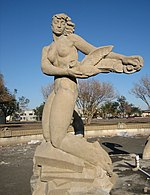| This article needs additional citations for verification. Please help improve this article by adding citations to reliable sources. Unsourced material may be challenged and removed. Find sources: "Enrique Alférez" – news · newspapers · books · scholar · JSTOR (September 2014) (Learn how and when to remove this message) |
| Enrique Alférez | |
|---|---|
| Born | May 4, 1901 San Miguel del Mezquital (now Miguel Auza), Mexico |
| Died | September 14, 1999 (aged 98) New Orleans, Orleans Parish, Louisiana, United States |
| Alma mater | School of the Art Institute of Chicago |
| Notable work | Molly Marine
Fountain of the Four Winds Symbols of Communication Louisiana at Work and Play |
| Style | Art Deco |
| Children | Tlaloc S. Alférez |
| Website | http://enriquealferez.com/ |


Enrique Alférez (1901–1999) was a Mexican artist who specialized in sculpting architectural reliefs and the human form.
Early life and education
Born in a rural village in northern Mexico, Alférez was introduced to sculpture by his father, a woodworker who was trained . He ran away at age 12, and was conscripted into the Constitutional Army during the Mexican Revolution. In 1920, he fled his home country and made his way to El Paso, Texas, where he found work as a photographer's assistant. It was here he attended a lecture presented by art teacher Lorado Taft, who was visiting El Paso on an Art Institute of Chicago tour. Seeing potential in the young man, Taft encouraged Alferez to come study under him in Chicago, which he did from 1927 through 1929.
Career
After completing his education in 1929, he moved to New Orleans, Louisiana, where he spent much of the rest of his life. He later married an American woman named Margaret, with whom he had a daughter.
His sculptures and reliefs adorn many parks, buildings, and landmarks in the New Orleans Metropolitan Area, many of them commissioned by the Works Progress Administration. Some of the most notable include those in City Park, as well as the "Molly Marine" statue, the first American sculpture to depict a woman in military uniform. His fountain at New Orleans Lakefront Airport is a well known local landmark. He made reliefs for a number of buildings, including the Charity Hospital Building in New Orleans and the Palmolive Building in Chicago.
Alférez was not only a sculptor, and actively produced work in other artistic disciplines. Notably, he painted an official portrait of Senator Huey P. Long (who he personally loathed, as he revealed decades later).
Alférez remained active into his later years, both as a working artist and an art teacher. In 1993, he appeared in a PBS American Experience documentary entitled "The Hunt for Pancho Villa".
In the years after Alférez's passing, author Katie Bowler Young began researching his work and went on to publish an extensive biography on his life titled "Enrique Alférez: Sculptor" in 2020 through the Historic New Orleans Collection.
Alférez’s influence and work is present throughout New Orleans. The Helis Foundation Enrique Alférez Sculpture Garden is named in his honor and located inside the New Orleans Botanical Garden. The garden is 8,000 sq. ft. and features over 20 of Alférez’s sculptures, most of which are owned by The Helis Foundation.
External links
References
- Johnson, Steve. "Story of Mexican art in Chicago is the story of Chicago art". chicagotribune.com. Retrieved 2018-04-15.
- "Dr. Tlaloc Alferez-Top Female Achiever". Retrieved 2018-11-06.
- "Women Marines: The Origin of Molly Marine | Semper Fi Parents". Archived from the original on 2013-05-29. Retrieved 2013-07-14.
- "Molly Marine". Women Marines Association. 2 September 2019.
- "Nude women sculptures now in City Park's beautiful new sculpture garden". WGNO. 2015-10-28. Retrieved 2018-11-06.
- Leighninger, Robert (14 August 2015). "Big Charity: The History of Charity Hospital". 64parishes.org. Louisiana Endowment for the Humanities. Retrieved 30 November 2020.
- "The Helis Foundation Enrique Alférez Sculpture Garden". The Helis Foundation. Retrieved 6 June 2024.
This article about an American sculptor is a stub. You can help Misplaced Pages by expanding it. |
- 1901 births
- 1999 deaths
- Artists from New Orleans
- School of the Art Institute of Chicago alumni
- Mexican sculptors
- Male sculptors
- Works Progress Administration workers
- 20th-century American sculptors
- 20th-century Mexican male artists
- Mexican-American culture
- American male sculptors
- Artists from Zacatecas
- Art Deco artists
- 20th-century American male artists
- 20th-century Mexican sculptors
- American sculptor stubs